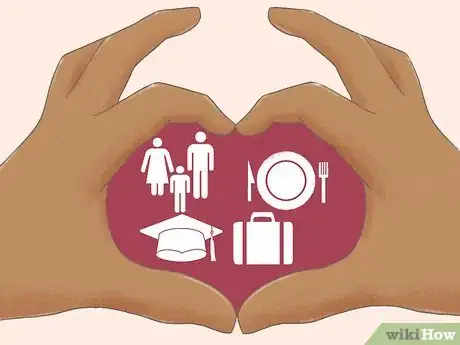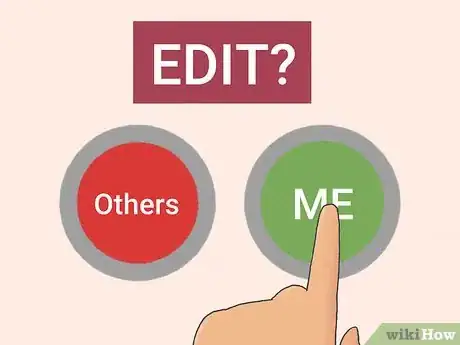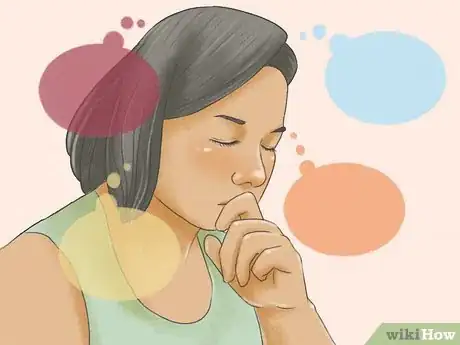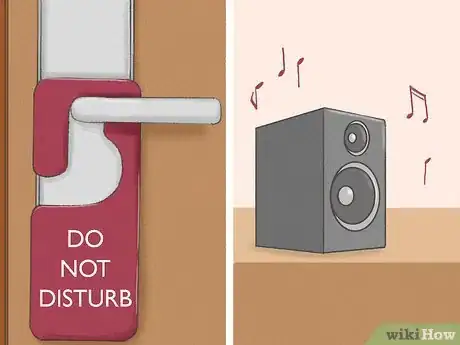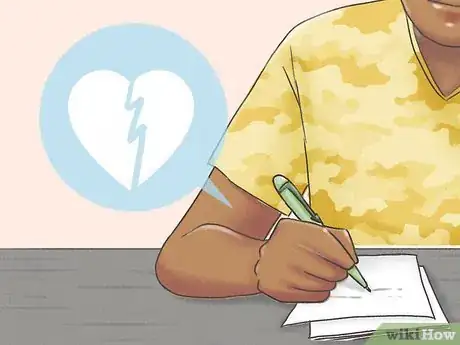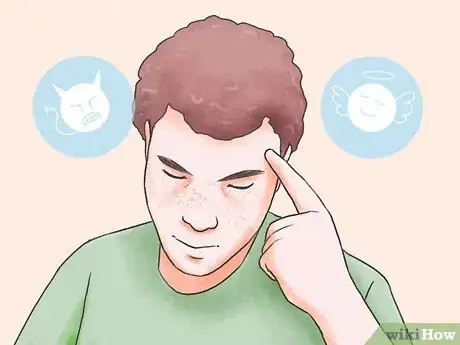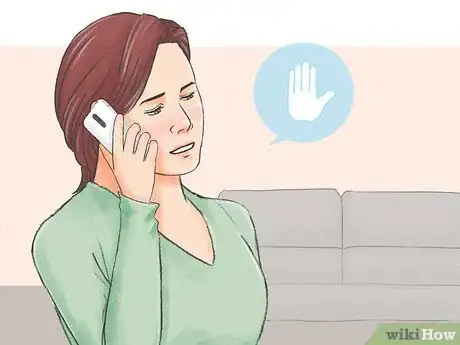This article was co-authored by Trudi Griffin, LPC, MS. Trudi Griffin is a Licensed Professional Counselor in Wisconsin specializing in Addictions and Mental Health. She provides therapy to people who struggle with addictions, mental health, and trauma in community health settings and private practice. She received her MS in Clinical Mental Health Counseling from Marquette University in 2011.
There are 16 references cited in this article, which can be found at the bottom of the page.
wikiHow marks an article as reader-approved once it receives enough positive feedback. This article received 13 testimonials and 89% of readers who voted found it helpful, earning it our reader-approved status.
This article has been viewed 219,556 times.
Looking for inner happiness and peace? Inner peace means you have a sense of harmony, emotional well-being and fulfillment in your life despite your current struggles (money, relationships, loss, etc). You can achieve this by practicing acceptance of yourself and the world around you, engaging in mindfulness, and meditation.
Steps
Practicing Acceptance
-
1Take a personal inventory. Acceptance of yourself is crucial to the promotion of inner peace because it enables us to be okay with what is currently happening no matter what the circumstances. If we try to avoid pain we may only enhance it. You can start by practicing acceptance of yourself by taking a personal inventory- who you are, what you look like, how you feel, and what you’ve done.
- Write down a personal inventory of your personality, characteristics (positive ones and ones you want to work on), actions, and appearance. Make a point to accept each and every part of your inventory – even the stuff you aren’t proud of. Forgive yourself for the wrongs you have done if you need to, and focus on what you can do today to better yourself.
- Take an inventory of your goals. Having dreams and aspirations is sometimes what keeps us moving forward in self-acceptance. Set personal goals for yourself and move toward them every day. Some examples of personal goals include: losing weight, eating healthier, exercising more often, picking up a new hobby (such as playing an instrument), or watching less television. On a daily basis, ask yourself if what you are doing is currently in line with your goals and values.
- Re-frame your negative traits into positive ones to promote self-acceptance. For example, perhaps you typically think that you are not tall enough and therefore, do not fully accept your height. You can practice self-acceptance by meaning-making about your height. What meaning or purpose might your height have? Does it help you do certain activities that a taller person might not be able to do? How does your height benefit you?
-
2Focus on what you are grateful for. One way to practice acceptance of your life is to be grateful for what you have instead of focusing on what you do not have.[1]
- Take an inventory of everything that you value in your life; this can include: family, friends, a roof over your head, enough food to eat, an education, the government, laws, nature, roads, and transportation. Remember that some people in the world may have little access to some of these things that we see as basic.
- You can even create a digital gratitude journal online through Thnx4.org and share your thoughts with others.[2]
Advertisement -
3Give up control over things you can't change. As humans, we often want to control others (what they do or how they act) and our environments (home, work, school, society, world). We want our spouse to be a better person, our boss to be nicer, our house to be cleaner, and traffic to evaporate. This is likely because we fear the unknown, or what we cannot control, including our own mortality. Unfortunately, we cannot always control these outcomes. Ultimately, we cannot control what others think, feel, or do.
- Focus only on what you can control.[3] Ask yourself, “What can I do in this situation?” If you can’t change it then accept it and let it go.
Engaging in Mindfulness
-
1Focus on right now. Mindfulness can help increase inner peace.[4] [5] Mindfulness is being aware of the current moment, the here and now, instead of thinking about the future or the past. Thinking of the past may lead to depressed mood or regrets, and thinking about the future can increase anxiety and worry. Being completely present in the current moment can increase your feelings of contentment.[6]
- Attempt to appreciate the current moment. Find positives about what is going on around you. For example, if you are at home – look out the window at the blue sky. What do you appreciate about the sky? What does it look like? Are there clouds, birds, or planes in the sky?
-
2Increase your awareness. Mindfulness is about increasing your awareness of yourself and the world around you. You can become more aware by focusing and taking control of your attention.
- Take a moment to look around you and notice the objects and people that are near. Focus on one particular object and become aware of what it looks like – it’s shape, color, texture, and purpose. Then touch that object; Is it soft, hard, or bumpy? Close your eyes and move your hands over the object. What does it feel like? It is cold or warm? What are the new and different things you notice about the object that you didn’t before?
-
3Observe your thoughts. Notice what thoughts come into your mind, like clouds passing through the sky, without judging, rejecting, or clinging to them. Simply let them pass through your mind.
- When you have a thought, notice it, and then let it go.
- One way to let go of thoughts is through visualization. Close your eyes and visualize a stream with leaves flowing down it. As you think a thought that is negative, place that thought on a leaf and watch it run down the stream until you cannot see it anymore.
-
4Engage in mindfulness exercises. Mindfulness techniques are a great way to practice mindfulness.
- One mindfulness technique is where you eat a piece of food (fruit, chocolate, etc.). Instead of just popping it into your mouth and chewing, start by observing the color and texture of the food, and then biting off a small piece. Eat that piece very slowly and notice how it tastes and feels in your mouth.
- Go on a mindfulness walk. This means you go for a walk, and while you are walking you notice everything that is going on in your mind, as well as around you. You can observe your own physical body in action and what is feels like to move (in your muscles, arms, legs).
- You can find many more mindfulness exercises online by conducting a google search, or locating videos on YouTube.[7]
Meditating
-
1Find a peaceful area. Meditation is associated with quiet reflection. First, find a good environment for meditation; this could be a quiet room, a peaceful meadow or sitting near a stream in the woods. Remove yourself from the rest of the world if you can.
- You may find this useful to do before you go to sleep.
-
2Limit distractions and get comfortable. Close doors and windows, and dim harsh lights. Limit clutter, traffic and noise levels. Light an aromatic candle if you wish.
- Ask others for this time alone. Place a "do not disturb" sign on the door to your room.
- If you choose, you can listen to slow, calming music.[8] Songs with harps, guitars or piano are particularly calming. If possible, avoid music with lyrics, as this may cause distraction and make it more difficult to focus.[9]
- Rest on your bed, in a chair, on the grass or a blanket. You can also choose to sit with your legs crossed.[10]
-
3Close your eyes and begin the meditation. Meditation can be done with eyes open or closed, but for beginners it can be easier with closed eyes in order to limit outside distractions.
- When you begin to meditate try not to think of anything else but inner peace (whatever that may mean to you). If images or thoughts stray, use encouraging words to concentrate or simply bring your attention back to the meditation.
- It's natural for your mind to wander - do not over-discipline. Brilliant ideas may arise from a wandering mind.
- After meditating, record any thoughts or feelings that may be helpful or of interest. Write the date and time to review progress.
-
4Try imagining or visualizing. There are other types of meditation such as visualization and imagery that prove useful for some individuals.[11] Try to control what you imagine or think of in your mind. This outcome may help you with everyday life and achievement of goals.
- Close your eyes and imagine yourself in a safe place where you can relax and be calm. This might be a beach, your bedroom, or in the middle of a garden. Notice how it feels in your safe place. Is it warm, soft, comforting? What do you hear? What do you see? Think about how it smells in your safe space. You can choose to stay there a while and when you are ready, open your eyes.[12] Reflect on how it felt to go to your safe place. Use this visualization any time you feel like you are not a peace.
- Imagine that you woke up in the morning and a miracle occurred - every problem you have was solved overnight. Visualize what you and your surroundings would look like. Where are you? What does it feel like? Who is around you? What do you hear? What are you doing?[13] This visualization helps with goal setting and achievement.[14]
-
5Meditate on art. Art education promotes inner peace and helps individuals feel relaxed and satisfied. Focusing art while you meditate can help inspire you, and give you a sense of freedom and wonderment.[15]
- Pick a piece of art (painting, sculpture, etc.) and focus on it for 5 minutes. What do you observe about the art? What emotions come up? Does a story play out in your mind? What thoughts come up for you?
- Appreciate the art and what it means to you. Enjoy it.
-
6Explore alternative forms of meditation. There are so many different types of meditation available to you. The more forms you explore, the more of an expert you will become at meditation and finding inner peace.[16]
- Try mantra or transcendental meditation where you repeat a word or phrase over and over again during your meditation.
- Do Yoga. Yoga involves doing poses that require concentration; this increases a sense of calm and presence in the current moment.
- Qi gong is a type of traditional Chinese medicine which focuses on creating balance through the combination of deep breathing, meditation, and physical movement.[17]
- Tai Chi is a Chinese marital art, which combines deep breathing with traditional Chinese poses in order to promote relaxation and wellness.[18]
Resolving the Past
-
1Speak with a therapist. If you have have experienced past traumas or abuse, it can be difficult to move past these experiences to attain inner peace. It can also be difficult to work on processing these experiences without help. If you are experiencing any of the following, especially if these feelings interfere with your ability to function in daily life, consider seeing a mental health professional:[19]
- Anxiety
- Insomnia or changes in your sleep habits
- Irritability or mood swings
- Flashbacks or memories that come upon you unwanted
- Feeling disconnected or isolated
- Feeling “shut down” or emotionless
- Depression
- Fears or phobias
- Difficulty concentrating or making decisions
- Feeling threatened or unsafe
- Thoughts or feelings of wanting to hurt yourself
-
2Join a support group. In many cases, resolving the past can be helped along by sharing your feelings and experiences with others, especially if they’ve had similar experiences. Talking to others about your past and how it has affected you allows you to explore the influence of these experiences. This can help you resolve and move through them to attain inner peace.[20]
- Support groups may be particularly helpful for victims of domestic violence and those who are struggling with an addiction.
- Try to share positive feelings and experiences with your support group as well as the pain.
- You may also find that joining a spiritual group is helpful to you.
-
3Explore the past through writing. Writing about your feelings and past experiences can help you process them. A journal gives you a safe space to record and explore your feelings without fearing anyone’s judgment. You can also use your journal to reflect on possible solutions and things you can do in the future.
- Just make sure that you do not end up judging yourself. Show yourself the compassion you would a beloved friend. For example, if you write about a painful experience that made you feel unloved, refrain from making judgments such as “I’m just unlovable.” Instead, show yourself kindness; “That experience really hurt, and that reaction is natural. I may need to look for love and support from others if this person continues to treat me this way.”
-
4Change your thinking. Many times, we learn negative habits of thinking from those in our lives, even when nobody realizes it. For example, if your father took things very personally, you may have learned to do so too. Try to note when you have a “gut reaction” or negative thought. Take a moment to examine the evidence for your reaction.
- Watch for personalization. It’s hard to have inner peace when you’re convinced everything is about you. For example, if your child’s teacher says that he needs more help with his homework, you might interpret this as a personal attack instead of what it really is: a statement of fact that your child needs help, and his teacher thinks you can offer it. Remind yourself that most things are not directed as personal attacks, and that you aren’t entirely responsible for everything.
- When you notice thoughts like this, or other thoughts that feel negative or disruptive, try looking for the evidence for your thought or feeling. Try to consider other ways to look at the situation. Remind yourself that a single negative experience does not characterize you, nor does it determine the future.[21]
-
5Set healthy boundaries. Sometimes, our relationships can keep us from attaining inner peace, especially if they’re unhealthy or insecure. It can be hard to set boundaries with people you’ve had in your life for a long time. Strengthen yourself and find your inner peace by setting healthy boundaries for yourself. Determine what your needs and values are and set guidelines according to those.
- For example, perhaps your mother calls you five times a day, even though you’re done with college and have moved out on your own and are not under her charge anymore. This may cause you a lot of stress. It’s okay to talk with her and say, “Mom, I appreciate that you want to stay in touch with me. I’ve got a lot of other things going on now that I’m out on my own, and I need to make enough time for them. Right now all these calls are making it hard for me. Let’s make a date to talk on Saturdays, okay? That way we can stay in touch and I can still get my other things done.”
Warnings
- This is not a quick fix. Accept that this will take time. The more you practice, the easier it will be.⧼thumbs_response⧽
- In finding inner peace, you may have to work your way through whatever it is that is inhibiting your peace.⧼thumbs_response⧽
References
- ↑ http://www.getselfhelp.co.uk/act.htm
- ↑ http://thnx4.org/
- ↑ http://www.getselfhelp.co.uk/mobile/options.htm
- ↑ https://onlinelibrary.wiley.com/doi/full/10.1002/smi.2551
- ↑ http://www.infactispax.org/volume2/Brantmeier.pdf
- ↑ http://www.actmindfully.com.au/upimages/Mindfulness_without_meditation_--_Russ_Harris_--_HCPJ_Oct_09.pdf
- ↑ http://greatergood.berkeley.edu/topic/mindfulness/definition#how_to_cultivate
- ↑ http://www.getselfhelp.co.uk/music.htm
- ↑ http://www.getselfhelp.co.uk/gallery1.htm
- ↑ http://www.getselfhelp.co.uk/meditation.htm
- ↑ http://www.getselfhelp.co.uk/imagery.htm
- ↑ http://www.getselfhelp.co.uk/imagery.htm
- ↑ http://www.getselfhelp.co.uk/imagery.htm
- ↑ http://solutions-centre.org/pdf/APT-2002-Iveson-149-56.pdf
- ↑ http://search.proquest.com/openview/d5f29194778c0a59bef945eb8dc55ce1/1?pq-origsite=gscholar
- ↑ http://www.mayoclinic.org/tests-procedures/meditation/in-depth/meditation/art-20045858
- ↑ http://www.mayoclinic.org/tests-procedures/meditation/in-depth/meditation/art-20045858
- ↑ http://www.mayoclinic.org/tests-procedures/meditation/in-depth/meditation/art-20045858
- ↑ http://www.helpguide.org/articles/ptsd-trauma/emotional-and-psychological-trauma.htm
- ↑ http://www.helpguide.org/articles/ptsd-trauma/emotional-and-psychological-trauma.htm
- ↑ http://psychcentral.com/lib/challenging-our-cognitive-distortions-and-creating-positive-outlooks/
About This Article
If you want to find inner peace, think about what you’re grateful for rather than what you don’t have. For example, take time to appreciate even basic things like your family, friends, and house. It may seem hard at first, but you should also only focus on what you can control and let go of things you can’t change, such as what others think or do. When you do both of these, you can feel more content and fulfilled with your life. Along with practicing acceptance, try meditating in a quiet, comfortable space. As you meditate, it’s natural for your mind to wander but try to bring your thoughts back to inner peace. Alternatively, you can practice yoga to achieve this sense of harmony. For more advice from our Counseling co-author, including how to move past traumatic experiences to achieve inner peace, read on!

